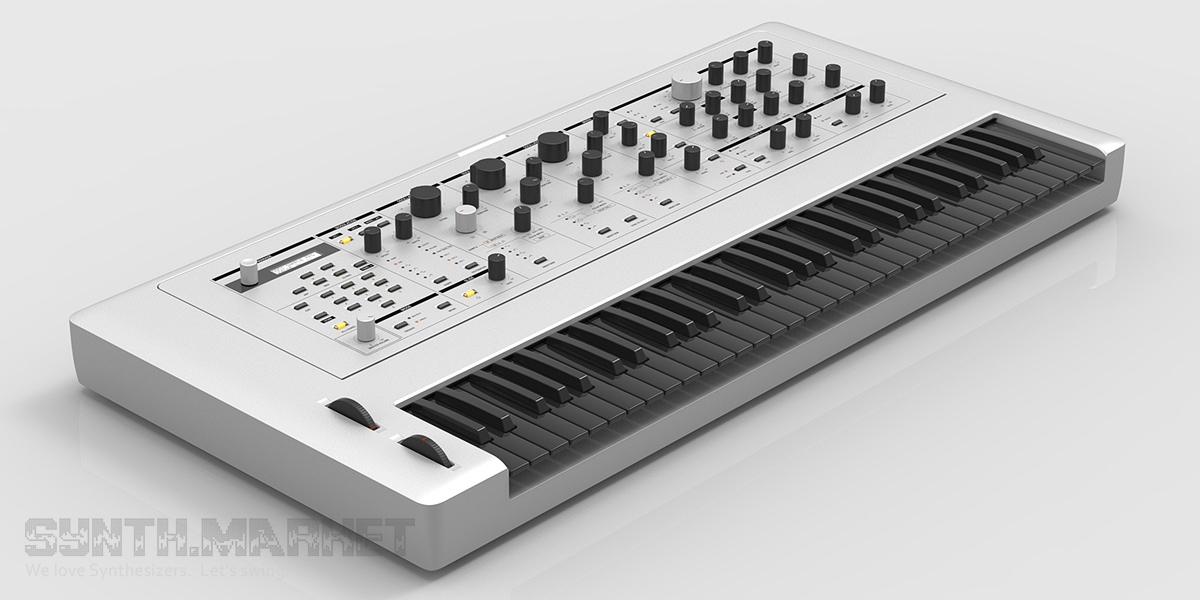The virtual analog synthesizer Hartmann 20 is the real work of art in the world of synthesizing - the brainchild of German industrial designer Axel Hartmann who created the design and components of this magnificent synthesizer in collaboration with colleagues from Design Box, Waldorf, SPL and Fatar.
It took more than 2000 working hours only to develop the concept of the interface and staggering amount of money for components and technologies used in manufacturing. It embraced all the best that Axel Hartmann, Design Box and Waldorf had achieved for the last 20 years, literally, and included the PPG wavetables, and the custom version of the virtual analog Waldorf sound engine, as well as the implementation of some of the capabilities of Hartmann Neuron - having its sounds sampled, and the sound path, built on the elements of the highest class from the German producer SPL. The unit really produces a stunning sound, excellent signal-to-noise ratio and channel split without interference.
Hartmann 20 will be released as a limited series of 40 units in magnificent housings, created with the high precision carving machines from solid aluminum blocks with an initial weight of 80kg. Twenty “20”s will be colored gray and another twenty units - black. All machines are only available if you pre-order making a 50% prepayment of a total cost of 20,000 euros. All the forty synthesizers will be configured in Germany and carefully assembled at the Studiologic Fatar facilities in Italy having their Fatar TP-8 top keyboard installed (which excels TP9S – the model which was chosen by Studiologic for the updated Sledge Black).
Let's go through the technical possibilities of Hartmann 20. The creation of the sound engine involved such eminent specialists as Dr. Peter Jung, Dr. Guido H. Bruck, Peter Gorges, Wolfram Franke, Erik Heirmann. The engine has a 24-voice polyphony, providing each voice with up to 3 main digital oscillators (recreating sine, triangular, rectangular, rectangular with PWM and sawtooth waveforms) and up to 2 LFOs of all major types, including S&H and Ramp. Frequency modulation is also provided for sine and triangular waves, as well as a noise generator (white/pink). For each voice two punchy envelopes are available - for the filter and attenuator. As for the filters, the lucky owner of the rare unit will receive a standard set of LPF, HPF, BPF 12dB and 24dB resonant self-oscillating filters. An arpeggiator with classic Up/Down/Up + Down modes is also available, as well as 2 parallel filter sets, one of which can include chorus, flanger, phaser, and the second one is a reverb, delay or reverb + delay simultaneously.
The creators admit that they did not reinvent the bike regarding the interface – they rethought the Studiologic Sledge interface for Hartmann 20 mainly to improve touch response replacing controllers with the new ones - all buttons became more "luxurious", all encoders and knobs are made of aluminum, Fatar TP-8 improved the quality comparing to the Fatar TP-9 keyboard for Sledge. Of course, as well as Sledge, Hartmann 20 uses the "one knob per function" approach and is great as a performance synthesizer. It is hard to imagine that someone will ruin such beauty taking it on stage, nevertheless, the concept implies that you can do it. The golden standards of German industrial design, in particular, the distance of the controls from each other - at least 40 mm, will not let your hands get tangled and pull something "wrong" and when unnecessary. By the way, the pitch/mod wheels are also made of aluminum, and are a little wider than the narrow wheel of Nord synthesizers. Their layout is interesting - not in a row, as in all synthesizers, but one above the other.
Among the connectivity features there are 1/4 "balanced outputs, headphone output, a pair of XLR outputs, 2 inputs for sustain and expression pedals, MIDI DIN input and output, USB to computer, certainly with MIDI support.
To sum up, we recall that there’s an instrument of a similar sophistication as much as the similar cost - Kurzweil K2500 Audio Elite System with a $20,000 price tag. But it was over 20 years ago, in the late 1990s, and K2500 AES is still a digital synthesizer based on the V.A.S.T. engine, which operates on samples. Here we also have, of course, a digital synthesizer, but its virtual-analog construction is capable of competing, for example, with John Bowen Synth Design Solaris. Although, let us repeat, Hartmann 20 is an incomparable object of modern art synthesis and an obvious confirmation that the Germans are making the best equipment in the world.
















